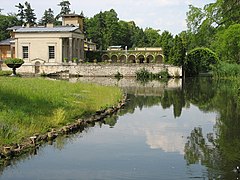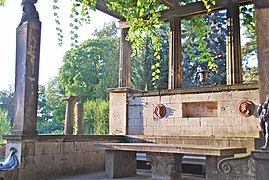Roman baths (Potsdam)
The Roman Baths , north-east of Charlottenhof Palace in Sanssouci Park in Potsdam , reflect the building owner Friedrich Wilhelm IV's " longing for Italy " . Various Roman / old Italian styles were brought together in the building ensemble from 1829–1840.
During his time as Crown Prince, Friedrich Wilhelm (IV.) Had Charlottenhof Palace (1826–1829) built and then the Roman Baths. With numerous ideas and design drawings, the artistically gifted heir to the throne had a great influence on the plans of the architect Karl Friedrich Schinkel . Construction management was entrusted to Schinkel's student Ludwig Persius .
The gardener's house (1829/30) and the gardener's assistant house (1832) were both built in the Italian country house style. The Roman bath (1834-1840), in the antique villa style and namesake of the building ensemble, and a tea pavilion (1830), in the style of an antique temple, form the building complex, connected by pergolas , arcades and garden parts. The individual buildings are made up of memories of Schinkel's second trip to Italy in 1828. The Roman bath, which was never bathed in, arose from the romantic fantasy of the royal Italy lover.
The names of the rooms indicate a mixture of an ancient villa and a Roman thermal bath . The atrium , the inner courtyard of a Roman house, is the reception room here. The impluvium , a collecting basin for rainwater in the atrium, is the name for an entire room behind the atrium. The Viridarium (green or cold house) is a small garden courtyard. The room names of a Roman thermal bath are only the apodyterium (changing room) and the caldarium (warm bath).
The nostalgic ensemble of the Roman Baths borders on an artificial lake, which was created by Peter Joseph Lenné's design of the Charlottenhof area. The so-called machine pond takes its name from a steam engine house with a pumping station that was demolished in 1923. A large well bowl marks the former location of the building. The steam engine not only kept the water in the Charlottenhof area moving, it was also a highly developed technique at that time, and smoking chimneys were a sign of progress.
Atrium with decorative tub made of green jasper (gift from Tsar Nicholas I to Friedrich Wilhelm IV.)
literature
- Kurt Kuhlow: The Royal Charlottenhof Palace near Potsdam . Berlin 1912.
- Gert Streidt, Klaus Frahm: Potsdam. The castles and gardens of the Hohenzollern. Könemann, Cologne 1996, ISBN 3-89508-238-4 .
- Official guide of the Prussian Palaces and Gardens Foundation Berlin-Brandenburg: Charlottenhof Palace and the Roman Baths . 7th revised edition, Potsdam 1998.
- Katharina Lippold: The terracotta sculpture in the park of Sanssouci under Friedrich Wilhelm IV. In: Foundation Prussian Palaces and Gardens Berlin-Brandenburg. Jahrbuch 1 (1995/1996), p. 93f ( digitized from perspectivia.net , accessed on February 22, 2013)
Web links
Coordinates: 52 ° 23 '51.9 " N , 13 ° 1' 41.9" E




